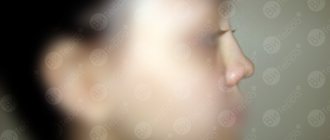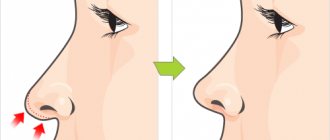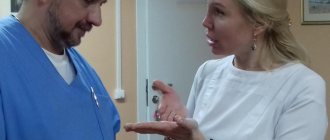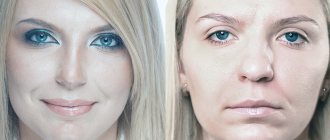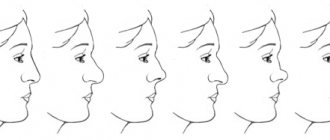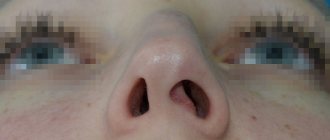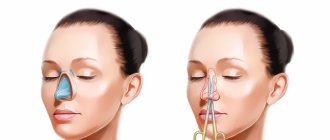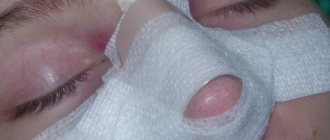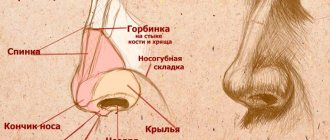Rhinoplasty involves not only correcting a wide or crooked bridge of the nose, but also correcting its wings, which may be too large, wide or asymmetrical in shape. All these defects can be corrected with the help of plastic surgery at the CONSTANTA Clinic in Yaroslavl, where trained and qualified specialists work, who have at their disposal all available methods of modern aesthetic surgery.
In some cases, correction can be carried out without surgical intervention. Non-surgical rhinoplasty also gives excellent results, allowing you to change the shape and size of the tip of the nose and nostrils using fillers. It is better to entrust the choice of a specific method to an experienced doctor at our Clinic. The specialist will definitely take into account the patient’s wishes, give professional advice and help determine the final appearance of the nose.
Indications for correction of the wings of the nose
Nostril surgery is performed according to indications. Before choosing a correction method, the doctor must conduct an examination, consultation, talk about the expected results and possible complications. The patient must have a good idea of what the nose will ultimately look like so that the plastic surgeon can understand what the patient wants and whether it is possible to achieve what he wants using surgical or non-surgical methods.
The main problems that can be solved with rhinoplasty:
- excessively long or wide wings of the nose, increasing its size;
- narrowed nostrils, which spoil the overall appearance of the nose and look unaesthetic;
- congenital or acquired asymmetry of the nostrils;
- retraction of the wings of the nose as a result of injuries;
- a nose that is too thick due to thickening of the cartilage and excess skin.
Almost any defect in the nasal tissue area can be solved with plastic surgery. The operation requires certain preparation and standard tests. The doctor will be able to tell you about the cost of the correction only after an examination. On the website you can find preliminary prices for the services of the Clinic’s specialists.
According to reviews from our patients, with the help of rhinoplasty, their appearance has noticeably improved; the doctor adjusted the shape and size of the nostrils so that the face looks as aesthetically pleasing as possible and at the same time natural. The results achieved are more clearly seen in the photos before and after the operation. But the appearance can be assessed only after the end of the recovery period, when the natural swelling of the tissues has subsided.
Contraindications for surgery
Rhinoplasty is not possible if the patient has the following health problems:
- exacerbation of chronic diseases;
- diabetes;
- bleeding disorders;
- oncological diseases.
Attention! All aesthetic plastic surgeries and most cosmetic procedures are strictly contraindicated for pregnant and lactating women. We also do not perform surgical interventions on people whose weight exceeds 110 kg.
How is the operation performed?
Most often, operations to correct the wings of the nose are performed under local infiltration anesthesia. Only with significant defects and a large volume of work can intravenous anesthesia be used. The type of anesthesia is selected by professional anesthesiologists at the Constanta Clinic. At the same time, they necessarily take into account factors such as the patient’s age, the presence of chronic diseases, and the state of the cardiovascular system. Regardless of what type of anesthesia is used, the patient will not feel any pain during the operation.
Sometimes it is possible to visually reduce the nostrils through just one correction of the tip of the nose. Therefore, changing the wings is the final stage of rhinoplasty. On average, the operation lasts 1.5-2 hours.
Results and discussion
The operations were performed under local infiltration anesthesia. During resection, we moved away from the edge of the tumor by 0.5 cm, resulting in a defect in the skin and the free edge of the nasal wing (Fig. 1). Then the protruding fragment of the future puzzle flap was marked on the skin of the medial part of the cheek. The shape and size corresponded to the area of the lost epithelial cover of the outer and inner surface of the nasal wing (Fig. 2). For greater accuracy, plastic templates and parameters of the contralateral subunit were used. Triangles of excess skin above and below the protruding fragment were excised to prevent deformity. The flap was separated in the lateral direction by 3.5–4.0 cm along the border of the subcutaneous layer and fascia. Mobilization was considered adequate when the cheek skin moved freely to the borders of the defect. As a result, a sliding puzzle flap was formed. Then a cartilage graft was formed from the costochondral complex of a cadaveric donor. The use of allogeneic material instead of the patient’s own cartilage made it possible to avoid additional trauma, reduce surgery time, and simulate a graft of any size and shape. To give a natural shape, we were guided by the intact wing of the nose. The thickness of the graft was 0.2 cm, the width was 0.5 cm, and the length was selected individually. A fragment of cartilage was placed in the projection of the free edge of the nasal opening, the end sections of the graft were immersed in prepared “pockets” at the edges of the wound and fixed with sutures (Fig. 3). The subcutaneous fat layer was removed from the protruding part with the exception of 0.5-0.6 cm at its base to reduce the risk of ischemia. After this, the flap was moved in the medial direction and fixed with a fasciocutaneous suture in the projection of the nasobuccal groove. The flap was bent according to the angle between the wing of the nose and the cheek. As a result, a well-defined groove was formed along the previously formed depression at the border of the protruding part of the puzzle flap. The lower part of the skin pad was bent inward through the cartilage graft, thus modeling the free edge of the nasal opening and eliminating the defect in the internal lining (Fig. 4). This avoids additional trauma to the nasal vestibule and is one of the differences from the classic design. To create a more pronounced nasobuccal groove, we excised a strip of skin at the border of the protruding and main parts of the flap (Fig. 5). The width of the strip is 0.2 cm, the depth is the epidermis and about one third of the dermal layer; in none of the observations were there any signs of impaired blood flow in the flap. This stage also distinguishes our method from the classical one. Interrupted sutures were placed on the edges of the wound (Fig. 6). If excess skin area was detected, the corresponding areas were excised.
Rice. 1. Defect of the nasal wing: a — patient 1; b — patient 2. Fig. 1. Defect of the wing of the nose: a - patient 1; b - patient 2.
Rice. 2. Puzzle flap cut design. Fig. 2. Design of the incision in the form of the puzzle flap.
Rice. 3. Transplantation of a fragment of allogeneic cartilage. Fig. 3. Transplantation of the allogenic cartilaginous fragment.
Rice. 4. Formation of a flap duplication. Fig. 4. Formation of the duplicate flap.
Rice. 5. Formation of a depression at the border of the protruding part of the flap. Fig. 5. Formation of the recess at the boundary of the protruding part of the flap.
Rice. 6. View after suturing the wound. Fig. 6. The appearance of the affected site after suturing the wound.
In both patients, it was possible to restore the lost outer skin and inner lining. The wounds healed by primary intention. There was no necrosis of the donor flap. During the first 3-4 weeks after surgery, the non-winged nose had a noticeably larger volume compared to the normal one. As the scar formed, the size decreased. Epithelization of the scar was completed by 8-9 days after surgery.
12 weeks after the operation, the patients were examined, an ultrasound examination of the non-winged nose, a questionnaire using the NAFEQ questionnaire, and a subjective assessment was carried out using VAS.
In one patient, the nasal wing was moderately dislocated in the dorsal direction (Fig. 7, a, b). The patient was not completely satisfied with the cosmetic result, but reported that her relatives were satisfied with her appearance and the scar did not attract the attention of strangers. Sum of points on the NAFEQ questionnaire: indicators of nasal function - 35 out of 35 possible, indicators of nasal appearance - 32 out of 35 possible. VAS score is 66 points, on the border of optimal and suboptimal results. The scar in the donor area completely satisfied the patient.
Rice. Fig. 7. View of the scar 3 months after reconstruction: a, b — patient 1; c, d — patient 2. Fig. 7. The scar within 3 months after the surgical reconstruction: a, b — patient 1; c, d — patient 2.
In the second patient, the winged nose was slightly thicker than normal. At the same time, the width of the nasal opening was normal, the contour of the subunit was not changed, the color and texture of the skin corresponded to natural ones (Fig. 7, c, d). Sum of points on the NAFEQ questionnaire: indicators of nasal function - 35 out of 35 possible, indicators of nasal appearance - 34 out of 35 possible. Your VAS score is 82 points, the optimal range. The scar in the donor area completely satisfied the patient.
Ultrasound examination of the non-winged nose showed that the allogeneic cartilage graft was located in the form of a volumetric hypoechoic structure with clear outlines, was surrounded by a fibrous capsule, and no signs of resorption were detected.
Common techniques for changing the wings of the nose
Depending on the problem, specialists select the necessary method of plastic correction of the nostrils:
- Reduction of the wings of the nose . Wedge-shaped incisions are made on the sides near the base of the nose, after which the wound edges are sutured. According to indications, it is possible to reduce the wings of the nose using oval and crescent-shaped incisions, which make it possible to reduce the length of the nostrils and visually make them more accurate.
- Narrowing of the wings of the nose . To achieve the desired result, the surgeon places sutures in the area of the lower part of the columella and then ties them, achieving a reduction in the width of the nostrils. Additionally, excess skin is excised and cosmetic stitches are applied.
- Recession of the nostrils . In this case, the volume of missing tissue is replenished using cartilage transplantation, which can be taken from the area of the ears or nasal septum. The patient’s own cartilage tissue is not rejected, and the risk of inflammatory processes and allergic reactions is minimal.
The technologies used in our Clinic are characterized by low trauma and efficiency. Patients receive qualified medical care and can be confident in the high quality of the services offered. Correction of the nostrils is carried out mainly during general rhinoplasty, but can also be used separately if the defects are located exclusively in the area of the wings of the nose.
How to visually reduce the wings of the nose
The easiest way to reduce the size of the nostrils and correct the shape of the nose is to use cosmetics or professional makeup. Women can be helped with this by makeup artists or online courses, as well as a set of decorative cosmetics. Unfortunately, this method is not very suitable for men, and proper application of makeup or make-up requires certain skills. However, this is the simplest and most painless, almost free method of correction.
It is also possible to slightly reduce the wings of the nose or shift them due to daily special exercises. Due to it, the tissues around the nose develop, blood circulation improves, tone and elasticity increase, which slightly changes facial features. This method is suitable for patient people who are solving minor, not very pronounced appearance problems.
Recovery period
The rehabilitation period after nostril surgery lasts 5-7 days. Cosmetic stitches are usually removed after 5-6 days. A few hours after the operation, the patient can go home if he feels satisfactory. For 24 hours, the nasal passages are plugged, and a plaster bandage is applied on top to ensure tissue immobility.
Throughout the entire rehabilitation period, physical activity, visits to baths, saunas, public pools and ponds are limited. It is forbidden to keep your head in a tilted position for a long time and sleep on your stomach. It is also better to avoid sunbathing and heavy lifting. During recovery, it is recommended to lead a calm lifestyle and avoid physical and psycho-emotional shaking. Don't be alarmed by the swelling that appears - this is a natural reaction of the skin and nasal mucosa to damage. They will soon subside and you will be able to enjoy your new appearance.
A repeat visit to the doctor in the absence of complaints about health is scheduled on the 7th day after surgery. The doctor will remove the plaster cast, remove the tampons from the nasal passages and perform an examination.
Preparation
To prepare for the procedure, 2 - 3 days are enough. Blood tests, urine tests, and an electrocardiogram are prescribed. The examination is carried out to ensure that there are no contraindications.
If local anesthesia is planned, you should not have a heavy breakfast on the day of surgery. It is better to carry out the manipulation on an empty stomach. If anesthesia is planned, eating any food is prohibited.
If you are sick or have a cold before the procedure, it is better to postpone it. Warn your doctor about this. For viral diseases, even minor interventions are not performed. This is due to the risk of complications.
Non-surgical rhinoplasty
For their patients who have minor defects, plastic surgeons at the CONSTANTA Clinic offer to correct them using non-surgical rhinoplasty. It involves the introduction of special gel fillers based on hyaluronic acid into the nostril correction areas. Fillers allow you to change the shape and size of the wings of the nose without incisions and subsequent rehabilitation, filling in areas with a lack of cartilage or soft tissue.
For this procedure, only high-quality and certified imported drugs are used.
The main thing when correcting the wings of the nose with fillers is the absence of tissue trauma, which inevitably occurs during plastic surgery. The patient receives the desired results immediately after the procedure.
Read more about rhinoplasty with fillers.
Types of operations
Rhinoplasty includes the following types of surgery:
- plastic surgery of the nasal septum - septoplasty;
- reduction of bone fracture;
- hump removal;
- shortening of the nose;
- bringing the nasal bones closer together;
- tip support and correction;
- correction of the wings of the nose;
- complete nose correction.
Depending on the method chosen by the surgeon, both closed and open approaches can be used when performing rhinoplasty. Closed rhinoplasty is performed through small incisions in the nasal cavity with detachment of the skin from the frame. The following types of operations are performed through closed access:
- change in shape;
- removal of excess nasal bone or cartilage;
- increasing volume, etc.
If the volume of surgical intervention is large, rhinoplasty is used through an open approach. Incisions are made in the columella, the vertical fold of skin that separates the nostrils.
In addition to traditional surgical rhinoplasty, non-surgical rhinoplasty using fillers has recently become very popular. This type of intervention is resorted to in order to solve the following problems:
- correct minor imperfections of the nose;
- achieve a rounded tip;
- restore symmetry, etc.
Rhinoplasty of the tip of the nose
Plastic correction of the tip of the nose includes a number of surgical operations performed on the tip of the nose.
It is possible to improve the shape by removing deforming or excess parts of cartilage tissue and fixing them in the correct position. Rhinoplasty of the tip of the nose is one of the most complex types of plastic surgery, allowing you to achieve the following results:
- narrowing or increasing the width of the tip of the nose;
- reduction or increase in projection;
- restoration of symmetry and natural shape of the nose.
The variety of anatomical variants of the nasal conic requires the surgeon to develop an individual surgical plan for each individual patient. When selecting a technique, various factors are taken into account:
- skin thickness;
- shape and strength of cartilage tissue;
- anatomy of arch angles;
- length and width of the nose;
- back contours;
- nasolabial angle;
- results expected by the patient.
Rhinoplasty
Correction of the wings of the nose can be carried out as an independent operation, or it can be one of the stages of a more extensive surgical intervention. Plastic surgery of the wings of the nose allows you to change the width, thickness, symmetry of the nostrils, correct various birth defects, and eliminate difficulty in nasal breathing due to too narrow nostrils and nasal passages.
Correction of a hump
Correction of the shape of the nose to correct a hump can be carried out both with and without surgical intervention - using the injection method. The choice of technique depends on the degree of deformation, as well as the wishes of the patient.
The surgical option of rhinoplasty involves the removal of cartilage or bone tissue through an external or internal incision. After the operation, stitches are applied. Another surgical correction method is resurfacing. The procedure allows you to correct a small hump without excision of bone structures.
A non-surgical rhinoplasty technique involves injecting a special filler under the skin, which will fill the pits, eliminating a small defect in just one session. The effect of this procedure lasts 1 – 1.5 years.
Correction of the nasal septum
This is a surgical correction of deformed cartilage or bone structures of the nose. This type of rhinoplasty is indicated for patients who have breathing problems due to a deformed nasal septum.
Columella correction
Columellaplasty is an aesthetic surgery aimed at correcting the size and shape of the septum that separates the nostrils. The columella plays a large role in the aesthetic perception of the face as a whole, and any changes in its size and shape can negatively affect the appearance.
Plastic surgery of the columella may be required if it is curvature, too large or, conversely, small in size, smoothness or sharpness of the nasolabial angle, etc. The columella is considered harmonious if it is located below the level of the wings.
Rhinoseptoplasty
Combined rhinoplasty, which includes correction of a deviated nasal septum, correction of the shape and size of the nose. The technique allows you to restore normal nasal breathing, eliminate deformations, as well as deviation of the nose. It can be performed using an open, closed or endoscopic method.
Possible complications after surgery
The risks of developing complications after rhinoplasty are minimal, but, unfortunately, cannot be completely excluded. Possible negative consequences of the postoperative period:
- persistent swelling that does not go away within six months;
- hematomas;
- addition of infection;
- hypertrophy of subcutaneous tissue within the surgical intervention or in the area of removal of cartilage tissue;
- disturbances of smell;
- nosebleeds;
- tissue necrosis.
